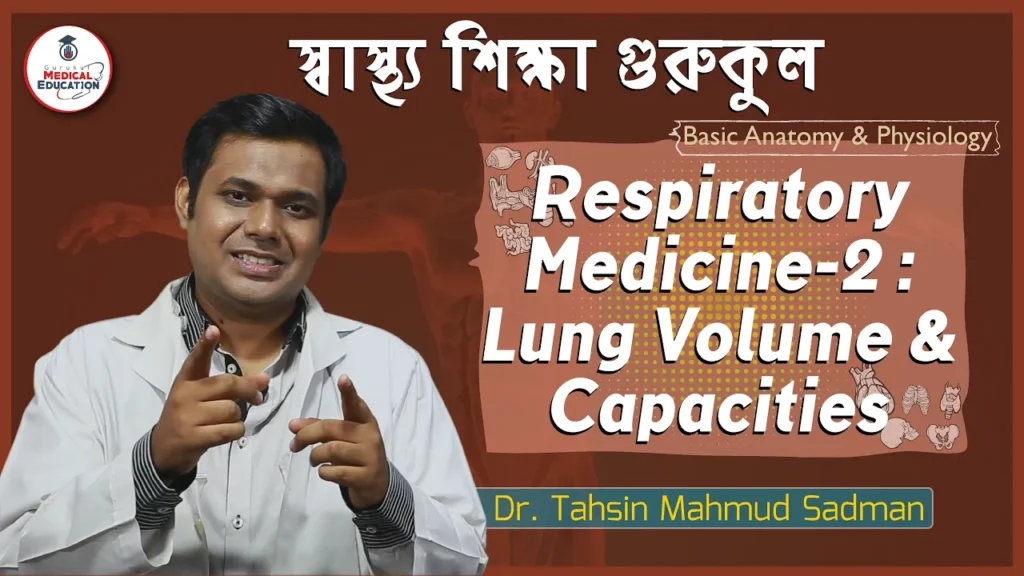Lung Volume and Capacities : The lungs are vital organs that play a critical role in our respiratory system, helping us breathe in oxygen and release carbon dioxide. In order to understand how well our lungs are functioning, it is important to measure and understand lung volume and capacities.
Lung Volume and Capacities:
Lung volume refers to the amount of air that can be held within the lungs at various stages of breathing. There are four main types of lung volumes:
Tidal Volume (TV):
Tidal volume refers to the amount of air that is inhaled or exhaled during normal, relaxed breathing. The normal tidal volume for an adult is around 500 mL.
Inspiratory Reserve Volume (IRV):
Inspiratory reserve volume refers to the amount of air that can be inhaled forcefully after a normal tidal volume inhalation. The normal inspiratory reserve volume for an adult is around 3,000 mL.
Expiratory Reserve Volume (ERV):
Expiratory reserve volume refers to the amount of air that can be exhaled forcefully after a normal tidal volume exhalation. The normal expiratory reserve volume for an adult is around 1,200 mL.
Residual Volume (RV):
Residual volume refers to the amount of air that remains in the lungs even after a maximal exhalation. The normal residual volume for an adult is around 1,200 mL.
See our class on this topic produced by Medical Gurukul.
Lung capacities:
Lung capacities, on the other hand, are combinations of two or more lung volumes. There are four main types of lung capacities:
Inspiratory Capacity (IC):
Inspiratory capacity is the maximum amount of air that can be inhaled after a normal tidal volume exhalation. The normal inspiratory capacity for an adult is around 3,500 mL.
Functional Residual Capacity (FRC):
Functional residual capacity is the amount of air that remains in the lungs after a normal tidal volume exhalation. The normal functional residual capacity for an adult is around 2,300 mL.
Vital Capacity (VC):
Vital capacity is the maximum amount of air that can be exhaled after a maximal inhalation. The normal vital capacity for an adult is around 4,500 mL.
Total Lung Capacity (TLC):
Total lung capacity is the maximum amount of air that the lungs can hold. The normal total lung capacity for an adult is around 6,000 mL.
Importance of Lung Volume and Capacities:
Measuring lung volume and capacities is important for several reasons. Firstly, it can help diagnose certain respiratory conditions, such as chronic obstructive pulmonary disease (COPD), asthma, and pulmonary fibrosis. These conditions can affect lung volumes and capacities, and monitoring them can help identify changes in lung function and disease progression.
Secondly, understanding lung volumes and capacities can help predict the risk of postoperative pulmonary complications. For example, patients with low lung volumes or capacities may be at a higher risk of complications after surgery, and may require additional respiratory support during and after the procedure.
Thirdly, measuring lung volumes and capacities can help evaluate the effectiveness of certain respiratory interventions, such as mechanical ventilation or bronchodilator therapy. Changes in lung volumes and capacities can indicate whether the intervention is helping to improve lung function.
Finally, understanding lung volumes and capacities can help athletes and individuals who engage in high-intensity physical activities. By measuring their lung volumes and capacities, they can optimize their breathing techniques and endurance, and improve their overall athletic performance.
Lung volume and capacities are important measures of lung function, which can help diagnose respiratory conditions, predict postoperative complications, evaluate respiratory interventions, and optimize athletic performance. Knowing the normal values for each type of lung volume and capacity is important for healthcare professionals, athletes, and individuals who want to maintain good respiratory health.
See more:

